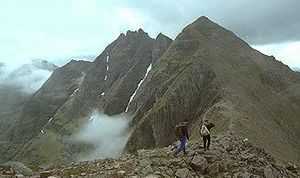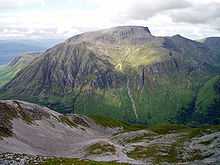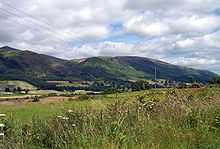Mountains and hills of Scotland
Scotland is the most mountainous country in the United Kingdom. The area north and west of the Highland Boundary Fault is known as the Highlands, and contains the country's main mountain ranges. Scotland's mountain ranges, in a rough north to south direction are: The Highlands & Islands, The Hills of the Central Lowlands, the Southern Uplands. The zone includes Britain's highest peaks, especially Ben Nevis at over 4000 feet, with several similar peaks in the Cairngorms.


Some of the most spectacular mountains occur in the northwest highlands, especially on Skye, the largest island off the coast. On the mainland nearby lie some great ranges based on the Torridonian sandstone, a Precambrian rock which overlies yet older rocks such as the Lewisian gneiss. Some of the highest peaks, such as Beinn Eighe are crowned by white quartzite, which gives those peaks a distinctive appearance. The trend continues to the north with larger caps of the white rock at Foinaven and Arkle (hill). Some of the quartzite contains fossilized worm burrows. It is known as pipe rock and is circa 500 million years old.
The formation continues to the north with gigantic peaks such as An Teallach near Ullapool and Stac Polly in Sutherland. The Torridonian rocks continue south to Applecross opposite Skye, where similar massive mountains occur. The Black Cuillin are mainly composed of basalt and gabbro, the latter being a very rough rock which makes for superb grip for mountaineers. It is from the dark colour of the gabbro that the Black Cuillin receive their name. The summits of the Cuillin are bare rock, jagged in outline and with steep cliffs and deep cut corries and gullies.
- The Northwest Highlands, lying to the north and west of the Great Glen.
- The Cuillin, on the Isle of Skye.
- The Grampians, the main belt of mountains across the centre of Scotland.
- The Cairngorms form the eastern part of the Grampians.
- The Torridon Hills of Wester Ross
The mountains exhibit many notable individual peaks and many exceed 3000 feet in height, so qualifying as Munros. Ben Nevis exceeds 4000 feet. To the south, Glen Coe has many notable mountains, such as Buachaille Etive Mòr and Bidean nam Bian, both of which are Munros. There is also a famous ridge walk, the Aonach Eagach, on the opposite side of the glen. The ridge is one of the most popular scrambles in the entire country, being a craggy arête with few escape routes.
The approximate southern-boundary of the Cairngorms range runs from slightly east of Braemar, west along Glen Dee to White Bridge, through Glen Geldie to the head of Glen Feshie. The western-boundary runs down Glen Feshie (northward) and the River Spey to Aviemore. The northern-boundary runs roughly eastward from Aviemore through Glen More to Glen Avon. The eastern-boundary then runs (southward) up Glen Avon, and over Am Bealach Dearg to slightly east of Braemar. The Cairngorms feature the highest, coldest and snowiest plateaux in the British Isles and are home to five of the six highest mountains in Scotland: Ben Macdui, Braeriach, Cairn Toul, Sgor an Lochain Uaine and Cairn Gorm. These mountains are all Munros, and there are a further 13 mountains with this categorisation across the area, of which another five are among the twenty highest peaks in the country.
To the south of the Cairngorms is a separate distinct range, The Grampians.
Hills of the Central Lowlands

The southern and eastern parts of Scotland are usually referred to as the Scottish Lowlands, but these areas also have significant ranges of hills, although these are lower than the Highland mountains. Because they are much closer to towns and cities, they are more popular for hill walking and rambling than the more distant mountains of the northern Highlands.
- The Sidlaws, north of Dundee but south east of the Highland Boundary Fault;
- The Ochil Hills, east of Stirling;
- The Campsie Fells, north of Glasgow;
In addition to the main ranges, there are numerous individual hills in the Lowlands, often volcanic in origin. Many are known by the Scots word Law, meaning hill.
The Southern Uplands

The Southern Uplands form a continuous belt of hills across southern Scotland from Galloway to the Borders. The Uplands are divided into several local ranges. The heartland of the Galloway hills lies to the north of Loch Trool and many excellent walks into that particularly wild remote territory start from the extensive car park by Bruce's Stone. There are three ridges which run northwards from the Loch Trool/Loch Dee/Clatteringshaws area - The Awful Hand on the west, The Rhinns of Kells to the east, and the Dungeon hills in between.
- Galloway Hills,
- Lowther Hills,
- Moffat Hills,
- Pentland Hills,
- Moorfoot Hills,
- Lammermuir Hills,
- The Cheviot Hills which lie mostly in England, and form part of the border between the two countries.
Scotland's highest mountains
The ten highest mountains in Scotland are also the ten highest in the UK.
- Ben Nevis 1344 m (4409 feet)
- Ben Macdui 1309 m (4295 feet)
- Braeriach 1296 m (4252 feet)
- Cairn Toul 1291 m (4236 feet)
- Sgor an Lochain Uaine 1258 m (4127 feet)
- Cairn Gorm 1244 m (4081 feet)
- Aonach Beag 1234 m (4049 feet)
- Aonach Mòr 1221 m (4006 feet)
- Càrn Mòr Dearg 1220 m (4003 feet)
- Ben Lawers 1214 m (3983 feet)
Listings
Scottish peaks are categorised by means of the following hill lists. Note that any one peak may ‘qualify’ for inclusion in several lists.
- The Munros are the most significant hills in Scotland over 3000 feet (914.4 m), according to original compiler Sir Hugh Munro. The list was first drawn up in 1891, and is modified from time to time by the Scottish Mountaineering Club (SMC). It currently comprises 282 peaks,[1] following the demotion of Sgurr nan Ceannaichean in September 2009 and of Beinn a' Chlaidheimh in 2012.[2]
- The Corbetts are hills in Scotland between 2500 and 3000 feet (762 and 914.4 m), with a relative height of at least 500 feet (152.4 m). The list is maintained by the SMC. There are currently 221 hills.
- The Grahams are hills in Scotland between 2000 and 2500 feet (609.6 and 762 m), with a relative height of at least 150 metres (492 ft). The list of hills fitting these criteria was first published by Alan Dawson in The Relative Hills of Britain.[3] under the provisional name Elsies (LCs, short for Lesser Corbetts). They were later named Grahams after the late Fiona Torbet (née Graham) who had compiled a similar list around the same time.[4] The SMC incorporated the list into Munro's Tables[5] in 1997. 224 hills are listed.
- The Donalds are hills in the Scottish Lowlands over 2000 feet (609.6 m). The list was originally compiled by Percy Donald, and is maintained by the SMC. It comprises 89 summits and 51 subsidiary tops, giving a total of 140 hills.
- The Marilyns are hills in the British Isles that have a relative height of at least 150 m, regardless of distance, absolute height or merit. The list was compiled and is maintained by Alan Dawson. There are 1216 Scottish Marilyns, see List of Marilyns in Scotland.
References
- ↑ SMC: List of Munros
- ↑ Beinn a' Chlaidheimh on munromagic.com
- ↑ Dawson, Alan (1992). The Relative Hills of Britain. Milnthorpe: Cicerone Press. ISBN 1-85284-068-4.
- ↑ Dawson, Alan (1999). The Grahams and the New Donalds. Cambuskenneth, Stirling: TACit Press. ISBN 0-9534376-0-4.
- ↑ Bearhop, D.A. (1997). Munro's Tables. Scottish Mountaineering Club & Trust. ISBN 0-907521-53-3.
See also
| Wikimedia Commons has media related to Mountains of Scotland. |
- Geography of Scotland
- Mountains of the United Kingdom
| ||||||||||||||||||||||||||||||||||

